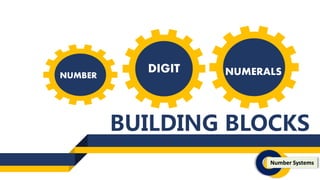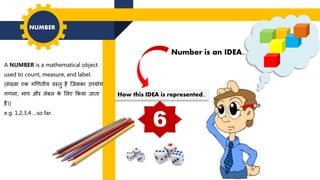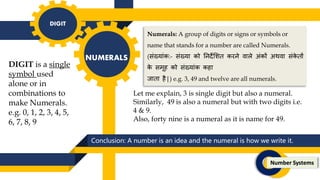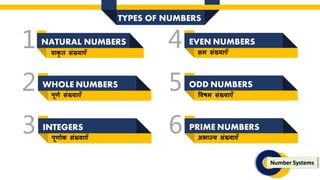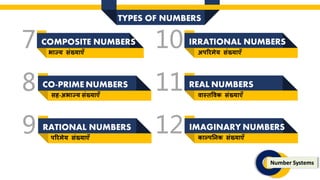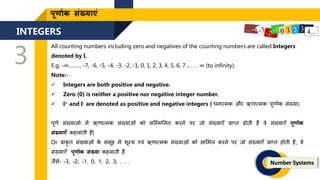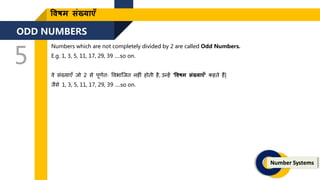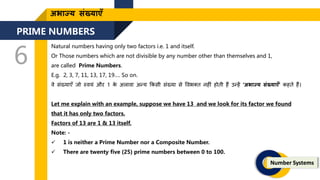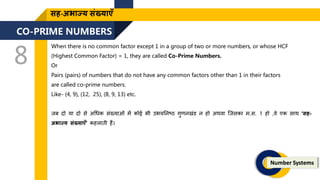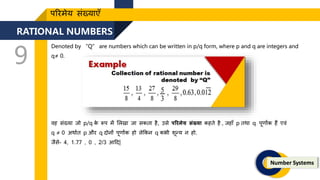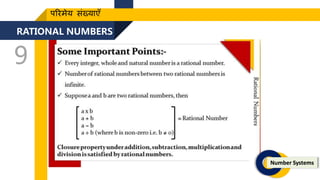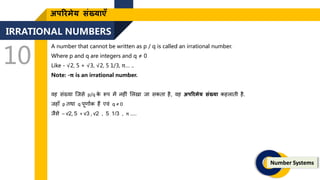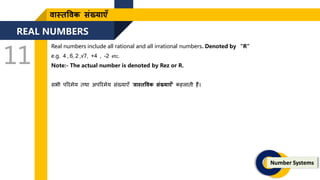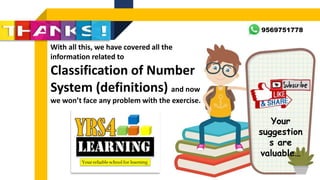Number system
- 1. Key facts about NUMBER SYSTEM. NUMBER SYSTEM | ý§∏ý§Çý§ñý•çý§Øý§æ ý§™ý§¶ý•çý§ßý§§ý§ø | ý§∏ý§Çý§ñý•çý§Øý§æ ý§™ý§¶ý•çý§ßý§§ý§ø ý§Æý•áý§Ç ý§Øý§æý§¶ ý§ïý§∞ý§®ý•á ý§Øý•ãý§óý•çý§Ø ý§™ý•çý§∞ý§Æý•Åý§ñ ý§¨ý§æý§øý•áý§Ç| Number Systems BY :- SUKHWINDER KUMAR For All Boards & Competitive Exams
- 2. NUMBER DIGIT NUMERALS BUILDING BLOCKS Number Systems
- 3. How this IDEA is represented.. Number is an IDEA.. 6 NUMBER A NUMBER is a mathematical object used to count, measure, and label. (ý§∏ý§Çý§ñý•çý§Øý§æ ý§èý§ï ý§óý§£ý§øý§øý•Äý§Ø ý§µý§∏ý•çý§øý•Å ý§πý•à ý§úý§øý§∏ý§ïý§æ ý§âý§™ý§Øý•ãý§ó ý§óý§øý§®ý§æ, ý§Æý§æý§™ ý§îý§∞ ý§≤ý•áý§¨ý§≤ ý§ï ý•á ý§≤ý§≤ý§è ý§ïý§ïý§Øý§æ ý§øý§æý§øý§æ ý§πý•àý•§) e.g. 1,2,3,4‚Ķ.so far.
- 4. Conclusion: A number is an idea and the numeral is how we write it. DIGIT NUMERALS Number Systems DIGIT is a single symbol used alone or in combinations to make Numerals. e.g. 0, 1, 2, 3, 4, 5, 6, 7, 8, 9 Numerals: A group of digits or signs or symbols or name that stands for a number are called Numerals. (ý§∏ý§Çý§ñý•çý§Øý§æý§Çý§ï:- ý§∏ý§Çý§ñý•çý§Øý§æ ý§ïý•ã ý§§ý§®ý§∞ý•çý§¶ý•áý§≤ý§øý§ø ý§ïý§∞ý§®ý•á ý§µý§æý§≤ý•á ý§Öý§Çý§ïý•ãý§Ç ý§Öý§•ý§µý§æ ý§∏ý§Çý§ï ý•á ý§øý•ãý§Ç ý§ï ý•á ý§∏ý§Æý•Çý§π ý§ïý•ã ý§∏ý§Çý§ñý•çý§Øý§æý§Çý§ï ý§ïý§πý§æ ý§øý§æý§øý§æ ý§πý•à|) e.g. 3, 49 and twelve are all numerals. Let me explain, 3 is single digit but also a numeral. Similarly, 49 is also a numeral but with two digits i.e. 4 & 9. Also, forty nine is a numeral as it is name for 49.
- 5. NATURAL NUMBERS 1 TYPES OF NUMBERS WHOLE NUMBERS 2 INTEGERS 3 EVEN NUMBERS 4 ODD NUMBERS 5 PRIME NUMBERS 6 ý§™ý•çý§∞ý§æý§ïý•É ý§ø ý§∏ý§Çý§ñý•çý§Øý§æý§èý§Å Number Systems ý§™ý•Çý§∞ý•çý§£ ý§∏ý§Çý§ñý•çý§Øý§æý§èý§Å ý§™ý•Çý§∞ý•çý§æý§æý§Çý§ï ý§∏ý§Çý§ñý•çý§Øý§æý§èý§Å ý§∏ý§Æ ý§∏ý§Çý§ñý•çý§Øý§æý§èý§Å ý§µý§øý§∑ý§Æ ý§∏ý§Çý§ñý•çý§Øý§æý§èý§Å ý§Öý§≠ý§æý§úý•çý§Ø ý§∏ý§Çý§ñý•çý§Øý§æý§èý§Å
- 6. COMPOSITE NUMBERS 7 CO-PRIME NUMBERS 8 RATIONAL NUMBERS 9 IRRATIONAL NUMBERS 10 REAL NUMBERS 11 IMAGINARY NUMBERS 12 Number Systems ý§øý§æý§∏ý•çý§øý§µý§øý§ï ý§∏ý§Çý§ñý•çý§Øý§æý§èý§Å ý§ïý§æý§≤ý•çý§™ý§§ý§®ý§ï ý§∏ý§Çý§ñý•çý§Øý§æý§èý§Å ý§Öý§™ý§∞ý§∞ý§Æý•áý§Ø ý§∏ý§Çý§ñý•çý§Øý§æý§èý§Å ý§™ý§∞ý§∞ý§Æý•áý§Ø ý§∏ý§Çý§ñý•çý§Øý§æý§èý§Å ý§∏ý§π-ý§Öý§≠ý§æý§úý•çý§Ø ý§∏ý§Çý§ñý•çý§Øý§æý§èý§Å ý§≠ý§æý§úý•çý§Ø ý§∏ý§Çý§ñý•çý§Øý§æý§èý§Å TYPES OF NUMBERS
- 7. NATURAL NUMBERS 1 Number Systems ý§™ý•çý§∞ý§æý§ïý•É ý§ø ý§∏ý§Çý§ñý•çý§Øý§æý§èý§Å All counting numbers are called Natural Numbers denoted by N. E.g. 1, 2, 3, 4, 5, 6, 7 ,. . . . ‚àû (to infinity). Note:- Ôɺ Natural numbers are always positive ( ý§ßý§®ý§æý§§ý•çý§Æý§ï ). Ôɺ 1 is the smallest ( ý§∏ý§¨ý§∏ý•á ý§õý•ãý§üý•Ä ) natural number. Ôɺ 0 ‚ÄúZero‚Äù is not a natural number. ý§µý•á ý§∏ý§Çý§ñý•çý§Øý§æý§èý§Å, ý§úý§øý§®ý§∏ý•á ý§µý§∏ý•çý§øý•Åý§ì ý§ïý•Ä ý§óý§øý§®ý§æ ý§ïý•Ä ý§øý§æý§øý•Ä ý§πý•à, ý§™ý•çý§∞ý§æý§ïý•É ý§ø ý§∏ý§Çý§ñý•çý§Øý§æ Or ý§µý§∏ý•çý§øý•Åý§ìý§Ç ý§ïý•ã ý§óý§óý§®ý§®ý•á ý§ï ý•á ý§≤ý§≤ý§è ý§úý§øý§® ý§∏ý§Çý§ñý•çý§Øý§æý§ìý§Ç ý§ïý§æ ý§™ý•çý§∞ý§Øý•ãý§ó ý§ïý§ïý§Øý§æ ý§øý§æý§øý§æ ý§πý•à, ý§âý§®ý•çý§πý•áý§Ç ý§óý§∞ý•çý§® ý§∏ý§Çý§ñý•çý§Øý§æý§èý§Å ý§Øý§æ ý§™ý•çý§∞ý§æý§ïý•É ý§ø ý§∏ý§Çý§ñý•çý§Øý§æý§èý§Å ý§ïý§πý§øý•á ý§πý•àý§Ç| Or ý§óý§óý§®ý§øý•Ä ý§ïý•Ä ý§™ý•çý§∞ý§ïý§øý§Øý§æ ý§ïý•ã, ý§™ý•çý§∞ý§æý§ïý•É ý§ø ý§∏ý§Çý§ñý•çý§Øý§æ ý§ïý§πý§æ ý§øý§æý§øý§æ ý§πý•à| ý§øý•àý§∏ý•á ;- 1, 2, 3, 4, 5, 6, 7, . . . . ‚àû (ý§Öý§®ý§Çý§ø ý§øý§ï).
- 8. WHOLE NUMBERS 2 Number Systems ý§™ý•Çý§∞ý•çý§£ ý§∏ý§Çý§ñý•çý§Øý§æý§èý§Å All counting numbers including zero are called Whole Numbers denoted by W. E.g. 0, 1, 2, 3, 4, 5, 6, 7 ,. . . . ‚àû (to infinity). Note:- Ôɺ Every natural number is whole number. Ôɺ 0 is the smallest ( ý§∏ý§¨ý§∏ý•á ý§õý•ãý§üý•Ä ) whole number. Ôɺ 0 ‚ÄúZero‚Äù is the starting number in whole numbers. ý§Øý§¶ý§∞ý•çý§¶ ý§™ý•çý§∞ý§æý§ïý•É ý§ø ý§∏ý§Çý§ñý•çý§Øý§æý§ì ý§Æý•áý§Ç ý§øý•Çý§®ý•çý§Ø (0) ý§ïý•ã ý§∏ý§úý§Æý§Æý§≤ý§≤ý§ø ý§ïý§∞ ý§≤ý§≤ý§Øý§æ ý§øý§æý§è, ý§øý•ã ý§µý•á ý§∏ý§Çý§ñý•çý§Øý§æý§èý§Å ý§™ý•Çý§∞ý•çý§£ ý§∏ý§Çý§ñý•çý§Øý§æý§èý§Å ý§ïý§πý§≤ý§æý§øý•Ä ý§πý•àý§Ç| Or ý§™ý•çý§∞ý§æý§ïý•É ý§ø ý§∏ý§Çý§ñý•çý§Øý§æ ý§ï ý•á ý§∏ý§Æý•Çý§π ý§Æý•áý§Ç ý§øý•Çý§®ý•çý§Ø ý§ïý•ã ý§∏ý§úý§Æý§Æý§≤ý§≤ý§ø ý§ïý§∞ý§®ý•á ý§™ý§∞ ý§øý•ã ý§∏ý§Çý§ñý•çý§Øý§æý§èý§Å ý§™ý•çý§∞ý§æý§™ý•çý§ø ý§πý•ãý§øý•Ä ý§πý•àý§Ç, ý§µý•á ‚Äòý§™ý•Çý§øý§£ ý§∏ý§Çý§ñý•çý§Øý§æý§èý§Å‚Äô ý§ïý§πý§≤ý§æý§øý•Ä ý§πý•àý§Ç| ý§øý•àý§∏ý•á- 0, 1, 2, 3, 4, 5, 6, 7, . . . ‚àû
- 9. INTEGERS 3 Number Systems ý§™ý•Çý§∞ý•çý§æý§£ý§ï ý§∏ý§Çý§ñý•çý§Øý§æý§èý§Ç All counting numbers including zero and negatives of the counting numbers are called Integers denoted by I. E.g. -‚àû‚Ķ‚Ķ.., -7, -6, -5, -4, -3, -2, -1, 0, 1, 2, 3, 4, 5, 6, 7 ,. . . . ‚àû (to infinity). Note:- Ôɺ Integers are both positive and negative. Ôɺ Zero (0) is neither a positive nor negative integer number. Ôɺ I+ and I- are denoted as positive and negative integers ( ý§ßý§®ý§æý§§ý•çý§Æý§ï ý§îý§∞ ý§ãý§øý§æý§§ý•çý§Æý§ï ý§™ý•Çý§øý§æý§æý§Çý§ï ý§∏ý§Çý§ñý•çý§Øý§æ) ý§™ý•Çý§øý§£ ý§∏ý§Çý§ñý•çý§Øý§æý§ì ý§Æý•áý§Ç ý§ãý§øý§æý§§ý•çý§Æý§ï ý§∏ý§Çý§ñý•çý§Øý§æý§ìý§Ç ý§ïý•ã ý§∏ý§úý§Æý§Æý§≤ý§≤ý§ø ý§ïý§∞ý§®ý•á ý§™ý§∞ ý§øý•ã ý§∏ý§Çý§ñý•çý§Øý§æý§èý§Å ý§™ý•çý§∞ý§æý§™ý•çý§ø ý§πý•ãý§øý•Ä ý§πý•à ý§µý•á ý§∏ý§Çý§ñý•çý§Øý§æý§èý§Å ý§™ý•Çý§∞ý•çý§æý§£ý§ï ý§∏ý§Çý§ñý•çý§Øý§æý§èý§Å ý§ïý§πý§≤ý§æý§øý•Ä ý§πý•àý§Ç| Or ý§™ý•çý§∞ý§æý§ïý•É ý§ø ý§∏ý§Çý§ñý•çý§Øý§æý§ìý§Ç ý§ï ý•á ý§∏ý§Æý•Çý§π ý§Æý•áý§Ç ý§øý•Çý§®ý•çý§Ø ý§èý§µý§Ç ý§ãý§øý§æý§§ý•çý§Æý§ï ý§∏ý§Çý§ñý•çý§Øý§æý§ìý§Ç ý§ïý•ã ý§∏ý§æý§≤ý§Æý§≤ ý§ïý§∞ý§®ý•á ý§™ý§∞ ý§øý•ã ý§∏ý§Çý§ñý•çý§Øý§æý§èý§Å ý§™ý•çý§∞ý§æý§™ý•çý§ø ý§πý•ãý§øý•Ä ý§πý•àý§Ç, ý§µý•á ý§∏ý§Çý§ñý•çý§Øý§æý§èý§Å ý§™ý•Çý§∞ý•çý§æý§æý§Çý§ï ý§∏ý§Çý§ñý•çý§Øý§æ ý§ïý§πý§≤ý§æý§øý•Ä ý§πý•àý§Ç. ý§øý•àý§∏ý•á- -3, -2, -1, 0, 1, 2, 3, . . .
- 10. EVEN NUMBERS 4 Number Systems ý§∏ý§Æ ý§∏ý§Çý§ñý•çý§Øý§æý§èý§Å Numbers which are completely divided by 2 are called Even Numbers. E.g. 2, 4, 6, 8, 10, 12‚Ķ.so on. ý§µý•á ý§∏ý§Çý§ñý•çý§Øý§æý§èý§Å ý§øý•ã 2 ý§∏ý•á ý§™ý•Çý§øý§£ý§øý§É ý§µý§µý§≠ý§æý§úý§øý§ø ý§πý•ã ý§øý§æý§øý•Ä ý§πý•àý§Ç ý§âý§®ý•çý§πý•áý§Ç ‚Äòý§∏ý§Æ ý§∏ý§Çý§ñý•çý§Øý§æý§èý§Å‚Äô ý§ïý§πý§øý•á ý§πý•àý§Ç| ý§øý•àý§∏ý•á 2, 4, 6, 8, 10, 12‚Ķ.so on.
- 11. ODD NUMBERS 5 Number Systems ý§µý§øý§∑ý§Æ ý§∏ý§Çý§ñý•çý§Øý§æý§èý§Å Numbers which are not completely divided by 2 are called Odd Numbers. E.g. 1, 3, 5, 11, 17, 29, 39 ‚Ķ.so on. ý§µý•á ý§∏ý§Çý§ñý•çý§Øý§æý§èý§Å ý§øý•ã 2 ý§∏ý•á ý§™ý•Çý§øý§£ý§øý§É ý§µý§µý§≠ý§æý§úý§øý§ø ý§®ý§π ý§Ç ý§πý•ãý§øý•Ä ý§πý•à, ý§âý§®ý•çý§πý•áý§Ç ‚Äòý§µý§øý§∑ý§Æ ý§∏ý§Çý§ñý•çý§Øý§æý§èý§Å‚Äô ý§ïý§πý§øý•á ý§πý•àý§Ç| ý§øý•àý§∏ý•á 1, 3, 5, 11, 17, 29, 39 ‚Ķ.so on.
- 12. PRIME NUMBERS 6 Number Systems ý§Öý§≠ý§æý§úý•çý§Ø ý§∏ý§Çý§ñý•çý§Øý§æý§èý§Å Natural numbers having only two factors i.e. 1 and itself. Or Those numbers which are not divisible by any number other than themselves and 1, are called Prime Numbers. E.g. 2, 3, 7, 11, 13, 17, 19‚Ķ. So on. ý§µý•á ý§∏ý§Çý§ñý•çý§Øý§æý§èý§Å ý§øý•ã ý§∏ý•çý§µý§Øý§Ç ý§îý§∞ 1 ý§ï ý•á ý§Öý§≤ý§æý§µý§æ ý§Öý§®ý•çý§Ø ý§ïý§ïý§∏ý•Ä ý§∏ý§Çý§ñý•çý§Øý§æ ý§∏ý•á ý§µý§µý§≠ý§ïý•çý§ø ý§®ý§π ý§Ç ý§πý•ãý§øý•Ä ý§πý•àý§Ç ý§âý§®ý•çý§πý•áý§Ç ‚Äòý§Öý§≠ý§æý§úý•çý§Ø ý§∏ý§Çý§ñý•çý§Øý§æý§èý§Å‚Äô ý§ïý§πý§øý•á ý§πý•àý§Çý•§ Let me explain with an example, suppose we have 13 and we look for its factor we found that it has only two factors. Factors of 13 are 1 & 13 itself. Note: - Ôɺ 1 is neither a Prime Number nor a Composite Number. Ôɺ There are twenty five (25) prime numbers between 0 to 100.
- 13. COMPOSITE NUMBERS 7 Number Systems ý§≠ý§æý§úý•çý§Ø ý§∏ý§Çý§ñý•çý§Øý§æý§èý§Å Those numbers which are completely divisible by any number other than themselves and 1, are called Composite Numbers. E.g. 4, 6, 8, 9, 10, 12, 14, 15, ‚Ķ‚Ķso on. ý§µý•á ý§∏ý§Çý§ñý•çý§Øý§æý§èý§Å ý§øý•ã ý§∏ý•çý§µý§Øý§Ç ý§îý§∞ 1 ý§ï ý•á ý§Öý§§ý§øý§∞ý§∞ý§ïý•çý§ø ý§ïý§ïý§∏ý•Ä ý§Öý§®ý•çý§Ø ý§∏ý§Çý§ñý•çý§Øý§æ ý§∏ý•á ý§™ý•Çý§øý§£ý§øý§É ý§µý§µý§≠ý§æý§úý§øý§ø ý§πý•ãý§øý•Ä ý§πý•à, ý§øý•ã ý§µý§π ý§≠ý§æý§úý•çý§Ø ý§∏ý§Çý§ñý•çý§Øý§æ ý§ïý§πý§≤ý§æý§øý•Ä ý§πý•à| Let me explain with an example, suppose we have 9 and we found that it has three factors i.e. 1, 9, 3. 9 = 1 X 9, 3 X 3 Note: -The composite number is both even and odd.
- 14. CO-PRIME NUMBERS 8 Number Systems ý§∏ý§π-ý§Öý§≠ý§æý§úý•çý§Ø ý§∏ý§Çý§ñý•çý§Øý§æý§èý§Å When there is no common factor except 1 in a group of two or more numbers, or whose HCF (Highest Common Factor) = 1, they are called Co-Prime Numbers. Or Pairs (pairs) of numbers that do not have any common factors other than 1 in their factors are called co-prime numbers. Like- (4, 9), (12, 25), (8, 9, 13) etc. ý§øý§¨ ý§∞ý•çý§¶ý•ã ý§Øý§æ ý§∞ý•çý§¶ý•ã ý§∏ý•á ý§Öý§óý§ßý§ï ý§∏ý§Çý§ñý•çý§Øý§æý§ìý§Ç ý§Æý•áý§Ç ý§ïý•ãý§à ý§≠ý•Ä ý§âý§≠ý§Øý§§ý§®ý§∑ý•çý§Ý ý§óý•Åý§øý§®ý§ñý§Çý§° ý§® ý§πý•ã ý§Öý§•ý§µý§æ ý§úý§øý§∏ý§ïý§æ ý§Æ.ý§∏. 1 ý§πý•ã ,ý§µý•á ý§èý§ï ý§∏ý§æý§• ‚Äòý§∏ý§π- ý§Öý§≠ý§æý§úý•çý§Ø ý§∏ý§Çý§ñý•çý§Øý§æý§èý§Å‚Äô ý§ïý§πý§≤ý§æý§øý•Ä ý§πý•àý§Çý•§
- 15. RATIONAL NUMBERS 9 Number Systems ý§™ý§∞ý§∞ý§Æý•áý§Ø ý§∏ý§Çý§ñý•çý§Øý§æý§èý§Å Denoted by ‚ÄúQ‚Äù are numbers which can be written in p/q form, where p and q are integers and q‚âÝ 0. ý§µý§π ý§∏ý§Çý§ñý•çý§Øý§æ ý§øý•ã p/q ý§ï ý•á ý§∞ý•Çý§™ ý§Æý•áý§Ç ý§≤ý§≤ý§ñý§æ ý§øý§æ ý§∏ý§ïý§øý§æ ý§πý•à, ý§âý§∏ý•á ý§™ý§∞ý§∞ý§Æý•áý§Ø ý§∏ý§Çý§ñý•çý§Øý§æ ý§ïý§πý§øý•á ý§πý•à , ý§øý§πý§æý§Å p ý§øý§•ý§æ q ý§™ý•Çý§øý§æý§æý§Çý§ï ý§πý•àý§Ç ý§èý§µý§Ç q ‚âÝ 0 ý§Öý§•ý§æý§£ý§ø p ý§îý§∞ q ý§∞ý•çý§¶ý•ãý§®ý•ãý§Ç ý§™ý•Çý§øý§æý§æý§Çý§ï ý§πý•ã ý§≤ý•áý§ïý§ïý§® q ý§ïý§≠ý•Ä ý§øý•Çý§®ý•çý§Ø ý§® ý§πý•ã. ý§øý•àý§∏ý•á- 4, 1.77 , 0 , 2/3 ý§Üý§¶ý§∞ý•çý§¶|
- 16. Number Systems RATIONAL NUMBERS 9 ý§™ý§∞ý§∞ý§Æý•áý§Ø ý§∏ý§Çý§ñý•çý§Øý§æý§èý§Å
- 17. IRRATIONAL NUMBERS 10 Number Systems ý§Öý§™ý§∞ý§∞ý§Æý•áý§Ø ý§∏ý§Çý§ñý•çý§Øý§æý§èý§Å A number that cannot be written as p / q is called an irrational number. Where p and q are integers and q ‚âÝ 0 Like - ‚àö2, 5 + ‚àö3, ‚àö2, 5 1/3, œÄ‚Ķ .. Note: -œÄ is an irrational number. ý§µý§π ý§∏ý§Çý§ñý•çý§Øý§æ ý§úý§øý§∏ý•á p/q ý§ï ý•á ý§∞ý•Çý§™ ý§Æý•áý§Ç ý§®ý§π ý§Ç ý§≤ý§≤ý§ñý§æ ý§øý§æ ý§∏ý§ïý§øý§æ ý§πý•à, ý§µý§π ý§Öý§™ý§∞ý§∞ý§Æý•áý§Ø ý§∏ý§Çý§ñý•çý§Øý§æ ý§ïý§πý§≤ý§æý§øý•Ä ý§πý•à. ý§øý§πý§æý§Å p ý§øý§•ý§æ q ý§™ý•Çý§øý§æý§æý§Çý§ï ý§πý•àý§Ç ý§èý§µý§Ç q ‚âÝ 0 ý§øý•àý§∏ý•á ‚Äì ‚àö2, 5 + ‚àö3 , ‚àö2 , 5 1/3 , œÄ ‚Ķ..
- 18. NATURAL NUMBERS Number Systems IRRATIONAL NUMBERS 10 ý§Öý§™ý§∞ý§∞ý§Æý•áý§Ø ý§∏ý§Çý§ñý•çý§Øý§æý§èý§Å
- 19. REAL NUMBERS 11 Number Systems ý§øý§æý§∏ý•çý§øý§µý§øý§ï ý§∏ý§Çý§ñý•çý§Øý§æý§èý§Å Real numbers include all rational and all irrational numbers. Denoted by ‚ÄúR‚Äù e.g. 4 , 6, 2 ,‚àö7, +4 , -2 etc. Note:- The actual number is denoted by Rez or R. ý§∏ý§≠ý•Ä ý§™ý§∞ý§∞ý§Æý•áý§Ø ý§øý§•ý§æ ý§Öý§™ý§∞ý§∞ý§Æý•áý§Ø ý§∏ý§Çý§ñý•çý§Øý§æý§èý§Å ‚Äòý§øý§æý§∏ý•çý§øý§µý§øý§ï ý§∏ý§Çý§ñý•çý§Øý§æý§èý§Å‚Äô ý§ïý§πý§≤ý§æý§øý•Ä ý§πý•àý§Çý•§
- 20. IMAGINARY NUMBERS 12 Number Systems ý§ïý§æý§≤ý•çý§™ý§§ý§®ý§ï ý§∏ý§Çý§ñý•çý§Øý§æý§èý§Å These numbers are complex numbers which can be written as real number multiplied by an imaginary unit ‚Äúi‚Äùcalled Imaginary Numbers. Square root of a negative number where it doesnot have definite value. Such as: ‚àí2 and ‚àí5 etc. Note: - Ôɺ The imaginary number is denoted by Imz. Ôɺ The imaginary number when squared results in negative number. ý§ãý§øý§æý§§ý•çý§Æý§ï ý§∏ý§Çý§ñý•çý§Øý§æý§Øý•ãý§Ç ý§ïý§æ ý§µý§óý§£ý§Æý•Çý§≤ ý§≤ý•áý§®ý•á ý§™ý§∞ ý§øý•ã ý§∏ý§Çý§ñý•çý§Øý§æý§èý§Ç ý§¨ý§®ý§øý•Ä ý§πý•àý§Ç , ý§âý§®ý•çý§πý•áý§Ç ý§ïý§æý§≤ý•çý§™ý§§ý§®ý§ï ý§∏ý§Çý§ñý•çý§Øý§æý§èý§Ç ý§ïý§πý§øý•á ý§πý•àý§Ç ý•§
- 21. With all this, we have covered all the information related to Classification of Number System (definitions) and now we won’t face any problem with the exercise. Your suggestion s are valuable… 9569751778


